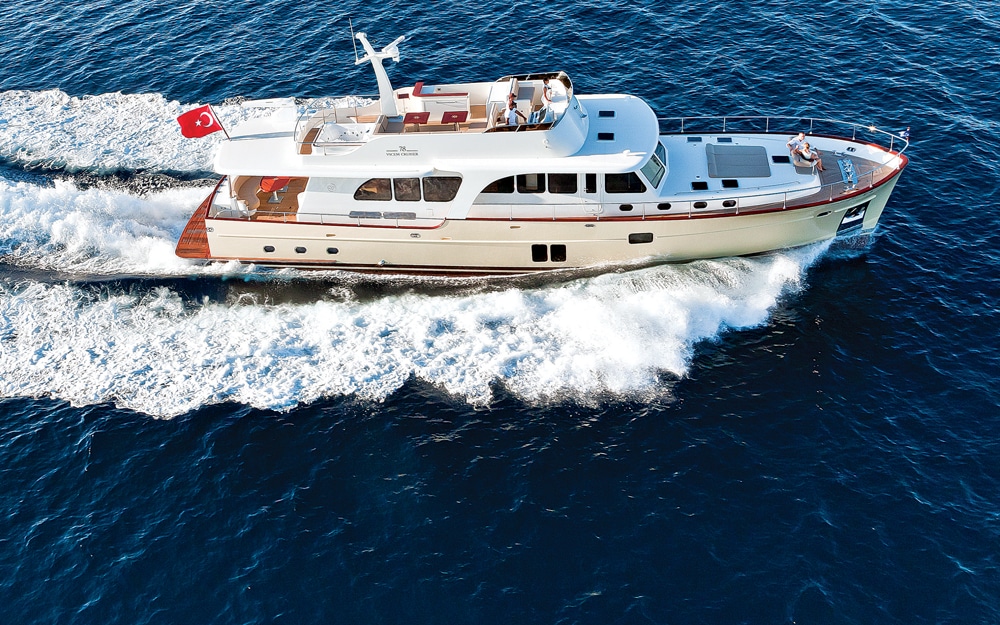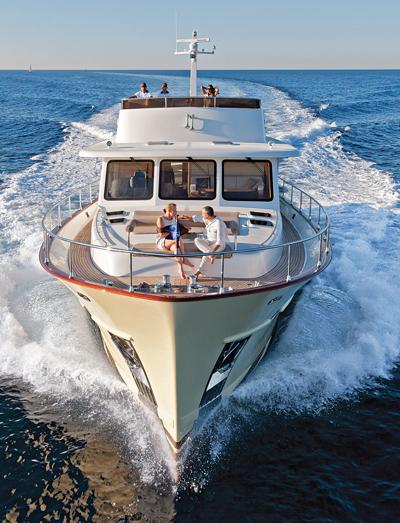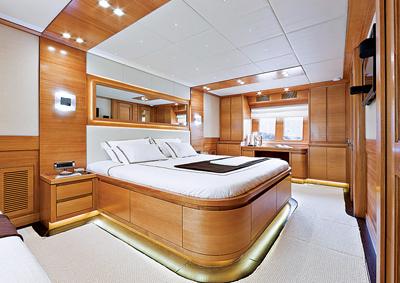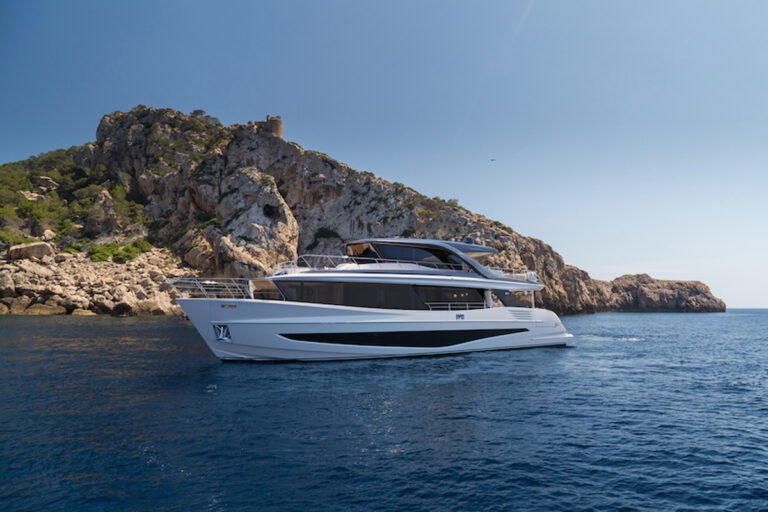
Vicem 78 Cruiser
As I stood admiring the Vicem 78 at the Fort Lauderdale International Boat Show, people would walk past and lower their voices as they spoke. “It’s wood, you know,” they would say sotto voce, as though they might offend the yacht with the comment.
It was, I realized, the natural result from half a century of advertising proclamations that fiberglass is the new miracle material. It never rusts or rots, it never needs painting, and, you’ll love this, it stays shiny forever. Pardon my French, but that’s pure BS, and anyone who owns a fiberglass boat knows it.
So I’d like to share another miracle material with you. Wood. If you have trouble remembering the name, think of this simple rhyme: “Wood is good.”
Wood has been good since men hollowed out tree trunks to venture onto scary waters. Wood has been good since ships sailed into battle with oars and sails. Wood has been good since clippers rounded the Horn in the China trade. And wood continues to be good for yachts built by skilled men who take great pride in both the craft they are building and the craft they use to build her.
Unlike fiberglass, wood is not created in laboratory test tubes, but by a seed that becomes a living thing. As the bumper stickers read when fiberglass was still newfangled, “If God wanted fiberglass boats, he would have made fiberglass trees.”
Let me tell you something else about wood. It is a great material for building yachts because water and wood are friends. Do I hear you snort with derision? Consider this. A wood chip floats naturally, no matter what its shape or whether it has any finish on it. Try that with a piece of fiberglass. Or steel. Or aluminum. Yes, water likes wood and allows it to float.
Wood provides natural insulation against sound and vibration, it has great strength combined with flexibility, and it is absolutely beautiful when properly finished. It doesn’t fatigue like many materials, and it doesn’t require expensive molds.
Those are just a few of the reasons why Vicem Yachts, a Turkish shipyard with a world-class reputation, chooses to use wood to build its 78 Cruiser. Vicem draws on a history of Turkish boatbuilding that dates back to Noah’s Ark and which, in more recent times, includes 10 centuries of experience starting with the galleons of the Ottoman Empire. The modern Vicem yard has employed many generations of the same families for years.
Located near Istanbul, which is the meeting point for East and West, Vicem isn’t afraid to combine classic woodworking skills with modern technology, and the 78 hull is built with a blend of wood and modern epoxy. Using cold-molded construction combined with West System epoxy resins, the Vicem 78 shares the best of old and new. Cold-molded construction involves laminating the hull over a form, using multiple skins of hand-selected mahogany at 45- and 90-degree angles so that the wood forms a multidirectional grid for strength.
Cold-molded construction has been around since before World War II, when it was used to build American PT boats and British Mosquito fighter bombers. Both were beloved by their crews because they were able to absorb incredible battle damage and still return home safely.
For the 78 Cruiser, each skin is marinated in epoxy resin to seal it against both air and water. After the veneers have been layered into a rigid hull, both the exterior and interior are sheathed with 10-ounce E-glass cloth, and, finally, the exterior is faired, primed and painted to a mirror finish.
“Vicem Yachts has a mission,” says Alberto Perrone da Zara, the company’s affable CEO, “to blend tradition with the most advanced technology. We don’t hope to build hundreds of production boats. We want to build the finest yachts for a clientele of a happy few.”

Those happy few are going to find a delightful yacht that is, at once, fun and sophisticated. Continuing its blending of old and new, Vicem is sure to please the experienced yacht owner with the 78’s classic lines that take full advantage of new ideas too. A gently curving sheer, a superstructure that doesn’t look like a floating condo, a well-proportioned flying bridge and subtle accents — from the stainless-steel anchor chafe plate to the planked-teak decks — make her timeless. Look up the word yacht in the dictionary, and you may well find a picture of the Vicem 78 there.
Once aboard, you might have been expecting the dark interior found on many classic designs and other Vicems, but you’ll be delightfully surprised: The 78 is as bright and cheerful as a luxury penthouse. Our test yacht had an interior of anigre, whose botanical name (Aningeria superba) says it all: superb. This is a light-colored tropical hardwood with a pleasantly wavy grain that shows off beautifully under the many-layered satin finish.
Light-toned wood can do a lot to brighten an interior, but the oversize salon windows are the real factor here. Not only are they low enough to give guests seated on the two facing settees a great view, but they also extend upward to the Roman blinds hidden in valances.
Stretching to the pilothouse bulkhead, the salon is divided into two areas by a single midcabin step. Aft is the entertainment and lounging area, with a flatscreen TV in one corner and sliding doors that open wide to include the curved settee and table on the afterdeck. Forward of the step is the formal dining area with uncrowded space for eight around an inlaid table.
Separated by a bulkhead with panels of anigre and a nubby fabric is the galley to port, and a chef’s delight indeed. Not only does it have a wall of Sub-Zero refrigerators and freezers on the after side, but also a dogging Murat door to the side deck that allows loading supplies without tracking through the salon. Opposite the galley is the day-head, which is accessible both to the pilothouse and the salon.
The pilothouse is impressive, with a burled-wood-and-leather-wrapped instrument panel that easily handles a pair of Raymarine E140 monitors plus a tidy array of engine and system panels. The pilothouse door is next to the helm, making it easy for the skipper to help when shorthanded, but others have to scrunch a bit to get past the big Stidd pedestal seat.
The reason for the scrunching is a good one, though: Directly behind the helm is a desktop for the skipper and a very comprehensive and well-labeled electrical panel behind doors. Opposite the helm is a triple-wide companion seat with a chart table on the dashboard and chart stowage underneath.
Guests reach their cabins via steps from the pilothouse, with a pair of cabins on each side of the passageway that leads forward to the larger guest stateroom in the bow. Like all the cabins, this stateroom is finished in acres of satiny anigre set off by a padded headboard over the queen berth. Two ports plus an overhead hatch provide light and air; drawers are under the raised berth, and a vanity is to starboard. The en suite head is contemporary with a Euro-styled vessel sink and a shower finished in mosaic tiles.
Because the passageway is slightly offset to starboard, the port guest cabin is a bit larger and thus gets the queen berth, while the other gets a pair of singles. Both have en suite heads, hidden rope lighting in the recessed overhead and good stowage.
The master suite has private stairs opposite the dining table, and it spans the full beam amidships with a king berth, the usual settee and desk/vanity on opposite sides under large windows, and more anigre. In fact, it’s hard not to stop and be impressed by Vicem’s woodworking skills, and where better than the master stateroom?
Above the padded headboard is a framed mirror to increase the visual space, and the frame very cleverly conceals rope lighting for a subtle effect. The nightstands appear to f loat above the dark wenge sole that perfectly accents the pale bulkheads; the grain-matched locker doors all have precise louvers cut by hand, and the self-closing drawers under the berth are perfectly finished.

Take the gently curving stairway from the cockpit to the bridge, and you’ll discover a spacious entertaining area. Our test yacht was due to receive a factory hardtop that would offer sun protection as well as some enclosure options for all-weather use. An optional four-person Jacuzzi spa was to starboard on this particular yacht, or the space could be devoted to sun chaises or more seating.
The midsection of the bridge has an L-shaped bar to port with a mahogany-capped counter and all the necessities from fridge and ice maker to stainless sink. On the forward console is a Wolf barbecue grill, so the area doubles as an alfresco galley.
Opposite is a large settee that wraps around a pair of cocktail tables that can be unfurled to create an immense dining table of Ottoman banquet proportions. The helm, with a doublewide Stidd seat, duplicates the lower station, and a bench seat is opposite for guests.
Abaft the entertaining area on the bridge is the boat deck, with room for both a RIB and a PWC, plus a davit.
Our test boat was powered by 900-horsepower MAN V-8 common-rail diesels, and, although MAN 1,100s are available for a bit more speed, I found the 900s just right for this yacht.
The engine room is reached via one of two crew areas, and I was pleasantly surprised that Vicem, unlike many European builders, treats the crew as equals. Not only were their quarters finished to the same high standard as the guests’, but they weren’t cramped. Reached through a dogging door on the port deck, there is a lounge with settee, table, TV and mini galley. The private cabin off the lounge has two single berths, and there is a civilized head with shower. Another single crew cabin is reached via the lazarette, and it also has a private head with shower. The lazarette includes laundry facilities and plenty of stowage.
A watertight door from the crew lounge leads into the engine room, which is simply immense. There is room to walk around the engines for service, but Vicem has put the Racor fuel and water filters on the centerline for easy access. The standard 27.5 kW Onan genset is aft and also accessible. All the systems, from the Reverso oil changers to the battery switches, are where you would put them in a perfect world. And I liked that Vicem labels its electrical and plumbing runs for future troubleshooting.
Our test day was, in a word, stinko. For starters, it was drizzling steadily and the wind had blown hard all night, leaving four-to-sixes outside, with an occasional eight-footer for spice. But the conditions also proved beyond question the mettle of the Vicem 78. Snug in the pilothouse with the wipers slapping back and forth, we cleared the entrance buoy and the bow rose. And rose. And rose.
And then it dropped into a frothy canyon.
We were, by this time, at something around low cruising speed, and yet the Vicem just shouldered the seas aside and hunkered down to business. No fuss, no muss. In fact, the entire time we were offshore, I tried to find an angle that might ruffle the aplomb of this yacht. And couldn’t.
Punching into the seas, she rode softly and threw the spray to the side, and the wipers easily dealt with any windblown spume that came aft. In a beam sea, the TRAC fin stabilizers took away the roll and lurch and, though I suspect they were flippering away busily far under our feet, the sensation was one of great calm. And when we ran down-sea, she had no tendency to bow-steer, which I expected because of the sharp entry that softened our up-sea runs.
We topped out just shy of 17 knots, and, in looking at the numbers we were recording, it was clear that she would be comfortable at several cruising speeds. At around 1,300 rpm, we were doing about 10 knots at a fuel burn that would give us a range of better than 1,000 miles. At a faster gallop around 1,900 rpm, we had a respectable 15 knots that would eat up the miles (albeit with shorter range) but still contribute to a long life for the diesels.
With a classic look that will remain timeless, a modern interior, impeccable construction and a long and seamanlike standard-equipment list, the Vicem 78 Cruiser is surely going to delight those “happy few” savvy enough to see her wonderful traits and seize the moment.
LOA: 82’0″
LWL: 74’9″
Beam: 21′
Draft: 5’9″
Displ.: 125,000 lb. (dry)
Fuel: 2,168 gal.
Water: 430 gal.
Deadrise: 8 degrees
Engine Options: 2 x 1,100-hp MAN V-10 1100
Engines Tested: 2 x 900-hp MAN V-8 900
Base Price: Upon request
**
Vicem Yachts, 954-713-0737; www.vicemyacht.com**









